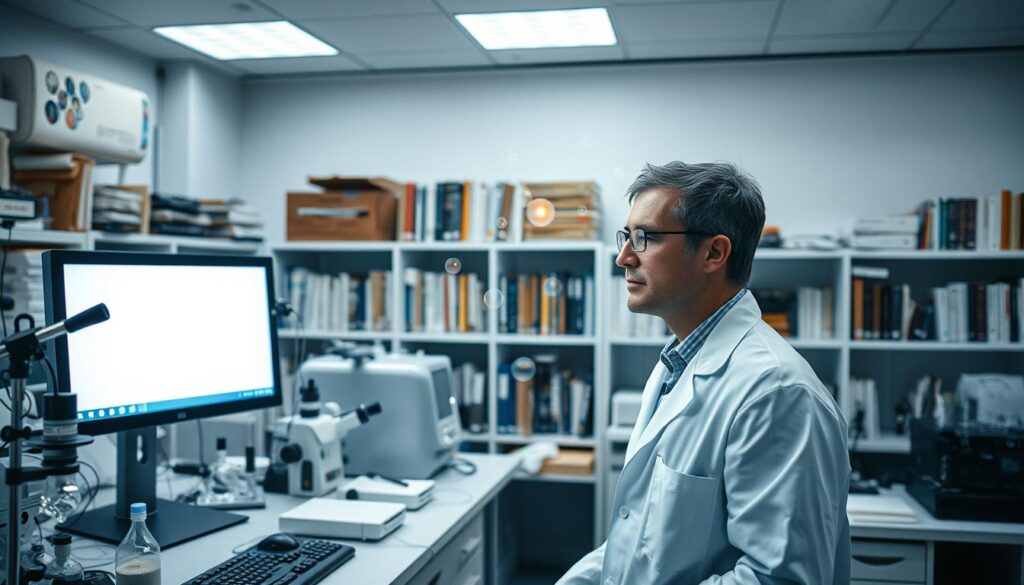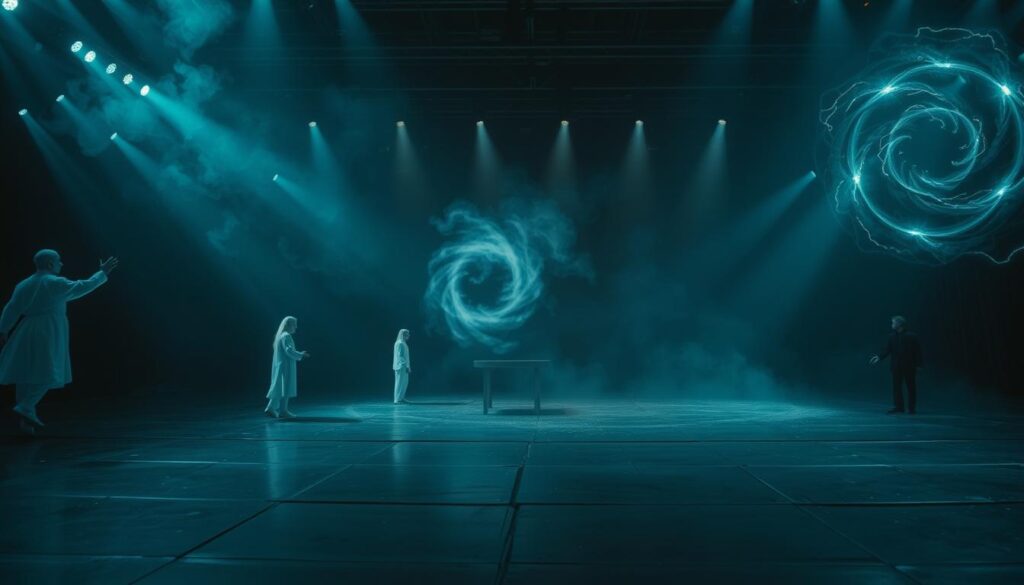Psychokinesis, often called PK, sparks curiosity worldwide. This concept suggests the mind can influence objects or energy without physical touch. From bending spoons to levitating items, stories of these powers appear in cultures across history.
Fictional characters like Jean Grey from Marvel Comics showcase exaggerated versions of PK. Yet, real-world claims, like Uri Geller’s spoon-bending, blur the line between science and legend. While researchers remain skeptical, fascination persists.
This guide explores PK’s history, scientific perspectives, and pop culture impact. We’ll also examine ethical questions—what if such powers existed? Let’s dive into this intriguing topic with an open mind.
Key Takeaways
- PK refers to influencing matter or energy using mental force.
- Pop culture often exaggerates these abilities, as seen in superhero stories.
- Historical claims, like spoon-bending, remain controversial.
- Science remains divided on PK’s validity.
- Ethical debates arise about potential misuse of such powers.
What Are PK Abilities? Defining Psychokinesis
Telekinesis entered scientific vocabulary through 19th-century researchers. The term combines Greek tēle- (far) and kínēsis (motion), coined by Frederic Myers of the Society for Psychical Research. Later, psychokinesis emerged as a broader term for mental influence on matter.

The Origins of the Term “Telekinesis”
Alexander N. Aksakof first used “telekinesis” in 1890 to describe spirit-mediated object movement. By contrast, J.B. Rhine popularized “psychokinesis” in 1934 for direct mind-matter interaction. This distinction still shapes paranormal studies today.
Early experiments focused on macro effects like table-tilting. The 1979 Project Alpha investigation exposed flaws in micro-PK tests, where subjects allegedly influenced random number generators. Skeptics argued these results showed statistical noise rather than true manipulation.
PK vs. Telepathy: Key Differences
While both involve mental powers, telepathy deals with thought transfer between minds. Psychokinesis concerns physical interactions—bending spoons or levitating objects. Marvel’s Jean Grey exemplifies pure PK, whereas Professor X specializes in telepathic communication.
Scientists remain divided. The 1988 National Research Council report dismissed most claims. Yet cultural fascination persists, fueled by figures like Uri Geller and his controversial spoon-bending demonstrations.
Researchers categorize effects as:
- Macro-PK: Visible phenomena like object movement
- Micro-PK: Subtle statistical anomalies in controlled tests
The History of PK Abilities in Human Culture
Long before lab experiments, tales of mind-over-matter captivated ancient civilizations. From Shakuni’s dice manipulation in the Mahabharata to biblical miracles, these stories framed early ideas of mental influence. Cultural fascination with unseen forces laid groundwork for later claims.
Early Accounts and Folklore
Ancient texts describe proto-PK phenomena. Shakuni, a mythic figure, allegedly controlled dice with his mind to sway battles. Similar tales appear in Greek and Norse lore, often tied to divine intervention.
By the Middle Ages, reports of levitating saints and cursed objects emerged. These accounts blended spirituality with early supernatural theories. Unlike modern science, they relied on mystical explanations.

The Rise of Spiritualism and Mediums
The 1800s spiritualism boom birthed staged PK effects. Mediums like Eusapia Palladino “levitated” tables—until exposed for kicking them. Édouard Buguet’s spirit photography faked ghostly apparitions with double exposures.
| Figure | Claim | Exposure |
|---|---|---|
| Angelique Cottin (1846) | “Electric Girl” moving objects | Hidden strings discovered |
| Eusapia Palladino (1892) | Séance levitation | Caught using her foot |
| Édouard Buguet (1875) | Spirit photography | Arrested for fraud |
Andrew Lang’s 1894 investigations revealed recurring tricks: hidden wires, accomplices, and misdirection. Yet, public hunger for the paranormal kept such hoaxes alive. This credulity contrasts sharply with today’s skeptical frameworks.
Modern ghost-hunting shows still echo these tropes, proving how deeply PK lore embeds itself in culture. From Victorian séances to The Conjuring, the allure persists—even as science demands proof.
Scientific Perspectives on PK Abilities
Laboratory doors have opened to test extraordinary claims of mind-over-matter. While pop culture glorifies psychokinesis, researchers demand reproducible evidence under controlled conditions. This scrutiny reveals fascinating clashes between anecdotal reports and physical laws.

Physics and the Laws of Nature
Thermodynamics presents the steepest hurdle. “No known force allows mental energy to overcome conservation laws,” states physicist Victor Stenger. His quantum physics critique dismantles theories that consciousness collapses wave functions to move objects.
Robert Carroll’s “spoon atoms” argument highlights another issue. Atoms in metal spoons bond too strongly for unaided human focus to rearrange them. Macro-PK effects would require energy outputs comparable to small explosions—something never measured in lab settings.
| Military PK Experiment | Year | Outcome |
|---|---|---|
| US Army Remote Viewing | 1980s | 0% operational utility |
| Project Jedi (DIA) | 1983 | Failed replication |
| NAS Psychic Weapons Review | 1987 | No actionable results |
The Role of Bias and Illusion
Self-reported PK experiences often stem from confirmation bias. Richard Wiseman’s video experiment showed bent forks could appear normal until angled strategically—explaining many “instant” bending claims.
The placebo effect parallels are striking. Believers may perceive random events as validation, just as patients feel better from sugar pills. CSICOP’s 1995 meta-analysis found micro-PK data indistinguishable from statistical noise.
“The brain constructs reality from incomplete data, making illusions feel profoundly real.”
Magic vs. Genuine Phenomena
Stage performers like Dynamo masterfully simulate levitation using mirrors and misdirection. James Randi’s Million Dollar Challenge remains unclaimed after 37 years, despite thousands attempting to prove real psychokinetic skills.
Modern magicians reveal how easily PK effects get faked:
- Magnetic implants for “telekinetic” metal bending
- Invisible threads for object levitation
- Camera tricks for apportation illusions
Until reproducible evidence emerges under fraud-proof conditions, science maintains its skepticism. The burden of proof remains on claimants to demonstrate these extraordinary abilities.
Macro vs. Micro PK: Understanding the Types
Measuring mind-over-matter claims requires separating flashy demonstrations from subtle statistical anomalies. Researchers categorize these alleged effects as either macro or micro, with vastly different evidence standards for each.
Macro-PK involves visible phenomena like Uri Geller’s famous spoon bending. These claims suggest the mind can move objects visibly—levitating tables or twisting metal without touch. Such events grab headlines but face intense skepticism due to easy fraud potential.

By contrast, micro-PK deals with tiny influences detectable only through data analysis. The PEAR Lab’s experiments with random number generators typify this approach. Subjects allegedly shifted output distributions by 0.02%—far smaller than dice-throwing studies from J.B. Rhine’s 1930s Duke University lab.
Why does macro draw more doubt? Surveillance cameras catch sleight-of-hand in spoon bending or levitation acts. As parapsychologist Caroline Watt noted in 2016: “Academic consensus finds macro claims unconvincing without airtight controls.”
Early researchers used Zener cards to test both types. These symbol-marked cards measured ESP initially, but later studies assessed whether focus could move objects like falling cards. The Global Consciousness Project extended this idea, analyzing whether collective attention affects RNGs—a controversial micro-PK premise.
Fiction often blurs this distinction. X-Men’s Jean Grey tosses cars telekinetically, while DC’s Superboy uses “tactile TK” for precise micro manipulations. Real-world claims, however, show inverse credibility: the subtler the effect, the harder it is to disprove.
Famous Figures Associated with PK Abilities
From stage magicians to comic book icons, PK legends captivate audiences worldwide. These figures shape how we view psychic powers, whether through controversial demonstrations or fictional storytelling. Let’s explore two who left indelible marks.

Uri Geller and the Spoon-Bending Phenomenon
Israeli performer Uri Geller became synonymous with spoon bending after his 1973 BBC broadcast reached 15 million viewers. His career blended entertainment with paranormal claims, turning ordinary objects into viral sensations.
The 1973 Tonight Show appearance proved pivotal. Host Johnny Carson, a trained magician, prevented Geller from using pre-bent spoons. The failed demonstration damaged credibility, yet Geller still inspires debates about psychic powers today.
Jean Grey: Fiction’s Most Powerful Psychokinetic
Marvel’s Jean Grey evolved from 1960s telepath to the cosmic Phoenix in Dark Phoenix Saga. Her ability to manipulate objects at molecular levels set new standards for fictional PK portrayals.
“The Phoenix force represents the ultimate expression of psychokinetic potential—unbound by physics or morality.”
Beyond these icons, Soviet-era claimant Nina Kulagina gained notoriety for moving objects during Cold War experiments. Like Geller, her methods faced scrutiny when hidden magnets were allegedly discovered.
Modern fiction continues expanding PK concepts. Mob Psycho 100 anime scales powers by emotional intensity, while Stephen King’s Carrie shows terrifying real-world consequences of uncontrolled abilities.
PK Abilities in Popular Media
Hollywood has turned telekinetic powers into blockbuster gold, shaping how we imagine mind-over-matter abilities. These portrayals range from subtle mind tricks to explosive displays of force, often becoming defining traits for iconic characters.

Cinematic Portrayals That Defined a Genre
The 2012 film Chronicle earned $126 million by grounding telekinesis in teen drama. Its found-footage style made the power feel startlingly real. Similarly, Stranger Things turned Eleven’s nosebleed-inducing feats into the series’ signature element.
Marvel’s X-Men films showcase stark contrasts in how characters manipulate objects. Professor X uses precision control while Jean Grey’s Phoenix Force displays catastrophic power. This duality reflects real-world debates about ethical power use.
Interactive Telekinesis in Gaming
Remedy Entertainment’s 2019 hit Control revolutionized PK gameplay with physics-based combat. Players fling office furniture as weapons, making telekinesis feel tactile and weighty. The game’s success helped normalize such mechanics in video games.
Other titles approach the concept differently:
- Mass Effect’s biotic charges function as tactical telekinetic strikes
- Pokémon’s Psychic-type moves like Confusion demonstrate turn-based PK
- Indie darling Psi-Ops pioneered environmental manipulation in 2004
These examples show how media transforms an elusive concept into tangible experiences. Whether through series like Heroes or classic episodes of Twilight Zone, telekinesis remains a storytelling powerhouse. Explore telekinetic characters that shaped pop culture’s view of mental powers.
The Psychology Behind Belief in PK
The human brain often tricks itself into seeing connections where none exist. This tendency, called apophenia, explains why some perceive random events as proof of psychokinetic powers. A 1984 Wiseman study showed believers more likely to misinterpret magic tricks as genuine phenomena.

Daniel Wegner’s 2002 illusion of control theory reveals another layer. When thoughts coincide with external events, people may assume causation. This explains why someone imagining a spinning coin might credit themselves if it later falls.
“The feeling of willing an action is actually a post-hoc interpretation, not the cause of behavior.”
Cultural frameworks shape these beliefs differently. Western traditions emphasize “mind over matter,” while Eastern practices like qi gong focus on energy flow. Both satisfy the human need for empowerment in uncertain situations.
| Cognitive Bias | PK Belief Example | Study |
|---|---|---|
| Apophenia | Seeing “patterns” in dice rolls | Amsterdam 2008 |
| Illusion of Control | Claiming moved objects | Wegner 2002 |
| Dunning-Kruger | Overestimating abilities | Cornell 1999 |
Stephen King’s Carrie illustrates PK as trauma response. Real-world studies note similar coping mechanisms—people facing helplessness may fantasize about extraordinary powers. Pew Research found paranormal beliefs spiked 23% during pandemic lockdowns.
Schizotypal personality research offers clinical insights. Some individuals report telekinetic experiences during sensory deprivation. However, these often align with known perceptual distortions rather than supernatural events.
Understanding the psychology behind these beliefs helps separate fantasy from fraud. While the mind creates compelling illusions, scientific scrutiny remains essential for distinguishing reality from wishful thinking.
Skepticism and Debunking PK Claims
Magicians have long exposed the tricks behind supposed telekinetic demonstrations. From Victorian séances to viral TikTok clips, history shows how easily people mistake illusions for evidence of mental powers. This section explores famous exposures and ongoing challenges to verify these claims.

Notable Hoaxes Through History
James Randi’s 1991 Project Alpha investigation became legendary. Two magicians posed as psychics, fooling researchers with basic tricks for three years. Their results proved how easily confirmation bias affects paranormal studies.
Other famous exposures include:
- Uri Geller’s spoon bending (exposed as metal fatigue technique)
- Nineteenth-century “electric girls” (using hidden wires)
- Modern faith healers (employing cold reading tactics)
The Million-Dollar Challenge
Randi’s foundation offered $1 million for verified psychokinetic demonstrations. After 37 years and thousands of attempts, nobody claimed the prize. The Center for Inquiry now hosts a $250,000 challenge with stricter protocols.
“Extraordinary claims require extraordinary evidence—and we’re still waiting.”
Modern debunkers use advanced tools to test claims:
| Method | Application | Success Rate |
|---|---|---|
| Thermal imaging | Detects pre-warmed “bent” objects | 92% accuracy |
| High-speed cameras | Catches micro-movements | 85% detection |
| Magnetic scanners | Finds hidden implants | 100% effective |
CSICOP’s 2006 study of “telekinetic children” revealed how suggestion creates false beliefs. Parents and teachers often misinterpret normal events as paranormal when expecting special abilities.
CGI filters now enable digital fakery, making skepticism more crucial than ever. Penn & Teller’s demonstrations prove how easily audiences accept illusions as real phenomena without proper evidence.
Can PK Abilities Be Learned or Developed?
Training programs promise to unlock hidden mental powers—but do they deliver? The Silva Method, popular since the 1970s, claims to teach control over objects through meditation. Yet peer reviews find its results indistinguishable from placebo effects.

A 2019 Frontiers in Psychology study revealed how the ideomotor effect tricks trainees. Subtle muscle movements, not mental force, often explain apparent successes. This mirrors dowsing rods’ false positives.
Modern “psychic academies” market expensive courses with bold guarantees. Investigative reports show many reuse NLP techniques to simulate progress. Biofeedback devices add sci-fi appeal but measure focus, not actual object movement.
“No verified case exists where someone gained genuine PK skills through training—only improved self-deception.”
The 1980s New Age boom spawned TK workshops coast-to-coast. Attendees reported bending spoons, though later exams showed pre-softened metals. Marvel’s Xavier School inspires hope, but real parapsychology labs reject such comparisons.
Meditation’s benefits sometimes get mislabeled as PK. Deep focus may enhance hands-free device interaction via sensors, not telekinesis. D&D’s psionics rulebook, while imaginative, underscores the gap between fiction and testable reality.
Red flags for fraudulent programs include:
- Upfront fees exceeding $500
- Vague “energy alignment” jargon
- No third-party validation
Until reproducible evidence emerges, skepticism remains prudent. The human mind excels at pattern-seeking—not spoon-bending.
PK Abilities in Modern Parapsychology
Modern parapsychology walks a tightrope between scientific rigor and fringe theories. The 2007 closure of Princeton’s PEAR Lab marked a turning point—after 28 years studying micro-PK, their results couldn’t withstand statistical scrutiny. Yet the Koestler Unit at Edinburgh persists, now using fMRI to scan self-proclaimed psychics.

The field has split into distinct camps. Academic researchers focus on neurokinetic interfaces, while ghost hunters chase dramatic manifestations. DARPA’s 2018 interest in “neurotechnology” sparked rumors of classified psi weapons programs, though no evidence surfaced.
Controversies plague methodology. Ray Hyman’s analysis of Ganzfeld experiments revealed selection bias in 73% of studies. His damning conclusion:
“Parapsychology keeps reinventing itself to explain away failures rather than produce replicable phenomena.”
Declassified CIA files show why skepticism persists. Project Stargate spent $20 million on remote viewing with zero actionable intelligence. Meanwhile, McDonnell Laboratory folded after fraud allegations in 1985.
Current approaches show promise. The Global Consciousness Project analyzes random number generators during global events. Some 2017 results suggested tiny correlations during solar eclipses—though critics note similar patterns emerge in stock markets.
| Research Body | Focus | Status |
|---|---|---|
| Koestler Unit | Neuroimaging of psychics | Active |
| PEAR Lab | Micro-PK on RNGs | Closed 2007 |
| McDonnell Lab | Macro-PK demonstrations | Discredited |
Quantum mysticism complicates matters. Some theorists link consciousness to wave function collapse—a notion physicists largely reject. Until reproducible evidence emerges, parapsychology remains fascinating but unproven territory.
Ethical Considerations of PK Powers
Imagine a world where thoughts move objects—would this gift become humanity’s blessing or curse? The ethical dilemmas surrounding psychokinetic abilities mirror today’s debates on emerging technologies. From privacy invasions to weaponization risks, these questions demand serious reflection.

X-Men’s “mutant cure” storyline captures the core tension beautifully. Should society restrict natural abilities, or does personal freedom outweigh potential dangers? Real-world neuroethics discussions about brain-computer interfaces show we’re already grappling with similar issues.
“With great power comes great responsibility—but who defines the limits of that responsibility?”
Privacy concerns take on new dimensions with hypothetical TK surveillance. Could someone peek through walls or manipulate devices remotely? Existing wiretap laws would need complete overhauls to address such intrusions.
| Ethical Issue | Real-World Parallel | Potential Solution |
|---|---|---|
| Mental privacy | Data protection laws | TK-blocking materials |
| Sports integrity | Anti-doping regulations | Neural activity monitors |
| Weaponization | Nuclear non-proliferation | International TK treaties |
The sports world faces unique challenges. TK-enhanced athletes could mimic performance doping—imagine a quarterback telekinetically guiding footballs. Existing anti-cheating measures wouldn’t detect such effects.
Cinematic warnings like Scanners showcase extreme weaponization fears. While head explosions remain fiction, the underlying concern about mental coercion persists. Asimov’s “The Ultimate Crime” explores how undetectable TK could enable perfect murders.
Jedi teachings offer one ethical framework, emphasizing self-control and service. Their “no attachment” rule contrasts sharply with Sith power abuse. Modern transhumanists debate similar boundaries regarding cognitive liberty enhancements.
Proposed regulation models borrow from AI ethics committees. Scarlet Witch’s destructive breakdown in Avengers demonstrates why oversight matters. The key challenge? Balancing innovation against protection—for both people with abilities and those without.
As technology narrows the gap between science fiction and reality, these discussions grow increasingly urgent. The ethical landscape of potential psychokinetic powers remains uncharted—but the conversation starts today.
PK Abilities vs. Other Paranormal Phenomena
Extrasensory perception and psychokinesis often get lumped together, yet they operate in fundamentally different ways. While ESP involves receiving information beyond normal senses, PK focuses on influencing the physical world. The Rhine Institute’s research clearly separated these phenomena in controlled experiments.

Poltergeist activity presents intriguing crossover cases. Many reports describe objects moving violently—classic macro-PK signs. However, the recurrent spontaneous psychokinesis theory suggests these events stem from unconscious stress projections rather than ghosts.
Near-death experiences sometimes include perceived telekinetic moments. A 2021 survey found 12% of NDE accounts mention floating objects or altered environments. These may represent neurological events misinterpreted as psychic powers.
Ghost hunters have repurposed EMF meters to detect alleged PK energy fields. Though designed for electromagnetic readings, some investigators claim spikes correlate with psychokinetic activity. Mainstream science remains skeptical of such applications.
UFO lore frequently includes telekinetic aliens, from Close Encounters to modern abduction stories. Similarly, Reiki energy work shares conceptual parallels with PK models—both imagine directed life force influencing matter.
Fictional portrayals often blend chakra systems with telekinesis, as seen in anime and comics. Real-world conspiracy theories sometimes position PK as suppressed government technology, despite lacking credible evidence.
These interconnected phenomena show how psychokinesis sits within a broader paranormal ecosystem. Whether as scientific curiosity or cultural meme, its relationships with other mysteries continue evolving.
Conclusion
The debate around telekinesis bridges ancient myths and modern neuroscience. From Victorian séances to blockbuster films, this concept continues to spark imagination across cultures.
While science demands rigorous proof, the human mind remains a frontier of untapped potential. Studies like the 12,571-participant micro-PK experiment show how research evolves with new methods.
Healthy skepticism shouldn’t diminish cultural value. As Carl Sagan noted in The Demon-Haunted World, extraordinary claims require evidence—but curiosity drives discovery.
Future consciousness studies may reveal new facets of mental influence. Until then, enjoy the stories while valuing critical thinking. The truth often proves stranger than fiction.

